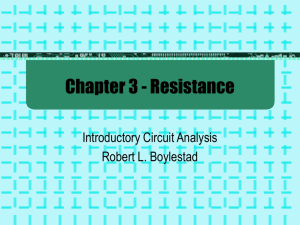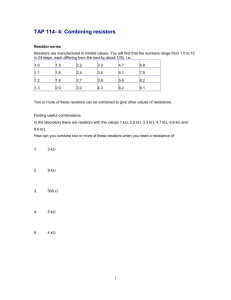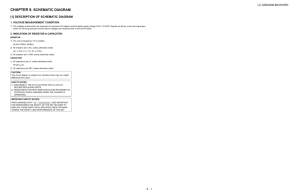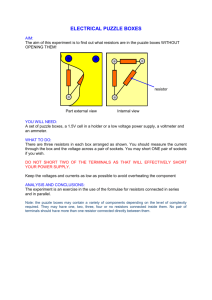ch03
advertisement
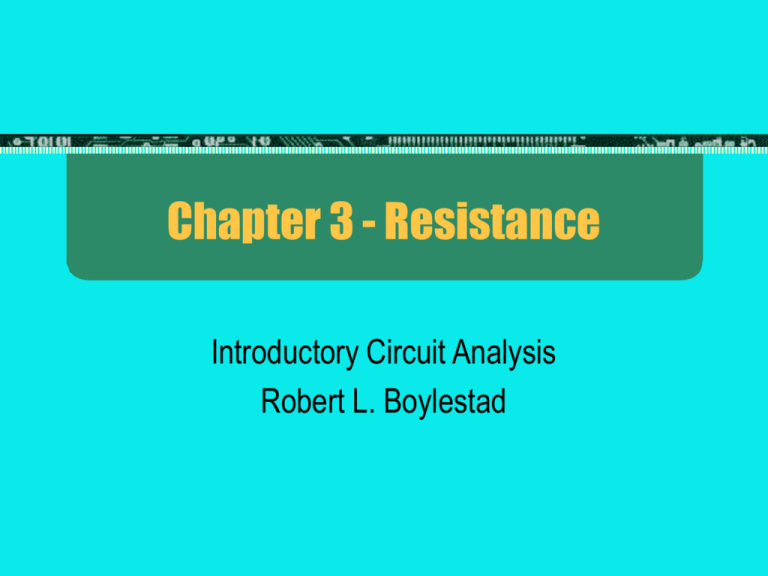
Chapter 3 - Resistance Introductory Circuit Analysis Robert L. Boylestad 3.1 – Introduction The resistance of any material with a uniform cross-sectional area is determined by the following factors: Material Length Cross-sectional Area Temperature Introduction Material and its unique molecular structure will react differently to pressures to establish current through its core Conductors – Permit generous flow of charge Insulators – Have high resistance Introduction As the temperature of most conductors increases, the increased motion of particles within the molecular structure makes it increasingly difficult for the “free” carriers to pass through, and the resistance level increases 3.2 Resistance: Circular Wires The higher the resistivity, the more the resistance The longer the length of a conductor, the more the resistance The smaller the area of a conductor, the more the resistance The higher the temperature of a conductor, the more the resistance Resistance: Circular Wires Area of a conductor is measured in circular mils (CM) The mil is a unit of measurement for length and is related to the inch by 1 mill = A wire 1 in. 1000 with a diameter of 1 mil has an area of 1 circular mil (CM) Resistance: Circular Wires Resistivity is not the only factor used in determining the best conductor. Other factors are: Malleability – ability of a material to be shaped Ductility – ability of a material to be drawn into long, thin wires Temperature sensitivity Resistance to abuse Cost Resistance: Circular Wires Copper is the most widely used material because it is quite malleable, ductile and available Aluminum was tried for general wiring but because of its thermal characteristics created difficulties Silver and gold are used but because of cost, they have been limited to places that justify the cost Tungsten has a resistivity three times that of copper but there are occasions when its physical characteristics (durability and hardness) are the overriding considerations 3.3 Wire Tables Designed to standardize the size of wire produced by manufacturers, it contains the following information: Cross-sectional area in circular mils Diameter in mils Ohms per 1000 feet at 20°C Weight per 1000 feet Maximum allowable current in amperes, as determined by the National Fire Protection Association The American Wire Gage (AWG) indicates cable size 3.4 Resistance: Metric Units Metric units are used in the design of resistive elements including thin-film resistors and integrated circuits Generally the meter is too large of a unit of measure for most applications, and so the centimeter is usually employed The resistivity of material is actually the resistance of a sample block 3.5 Temperature Effects Temperature has a significant effect on the resistance of conductors, semiconductors and insulators For good conductors, an increase in temperature will result in an increase in the resistance level. Consequently, conductors have a positive coefficient For semiconductor materials, an increase in temperature will result in a decrease in the resistance level. Consequently, semiconductors have negative temperature coefficients As with semiconductors, an increase in temperature will result in a decrease in the resistance of an insulator. The result is a negative temperature coefficient Temperature Effects Inferred absolute temperature Resistance increases almost linearly with an increase in temperature to the inferred absolute temperature of - 234.5 C INSERT FIGURE 3.14 Temperature Effects Temperature coefficient of resistance The higher the temperature coefficient of resistance for a material, the more sensitive the resistance level to changes in temperature When we use the temperature coefficient equation we see that copper is more sensitive to temperature variations than is silver gold or aluminum Temperature Effects PPM/°C The specification Parts Per Million Per Degree Celsius (PPM/°C) provides an immediate indication of the sensitivity level of a resistor to temperature 3.6 Superconductors Superconductors are conductors of electric charge that, for all practical purposes, have zero resistance The relatively low speed of electrons through conventional conductors is due to collisions with atoms and repulsive forces from other electrons Cooper effect: Electrons travel in pairs and help each other maintain a significantly higher velocity through the medium Superconductors The goal Superconductivity before 1986 of superconductivity at room temperature could only be established for temperatures colder than 23 K Superconductivity after 1986 Physicists Alex Muller and George Bednorz of the IBM Zurich Research Center found a ceramic material, lanthanum barium copper oxide that exhibited superconductivity at 30 K Professors Paul Chu and Man Kven Wu raised the temperature to 95 K using a superconductor of yttrium barium copper oxide, enabling liquid nitrogen (boiling point 77 K) to be used for cooling 3.7 Types of Resistors Resistors are made in many forms but all belong in either of two groups: Fixed resistors – are made of metal films, high-resistance wire or carbon composition Variable resistors – have a terminal resistance that can be varied by turning a dial, knob, screw, or anything else appropriate for the application Types of Resistors Variable resistors can have two or three terminals, but most have three Variable resistors are classified as a rheostat or potentiometer, depending upon the application Rheostat: Two- or three-terminal device used as a variable resistor Potentiometer: Three-terminal device used for controlling potential levels Types of Resistors Most potentiometers have three terminals as shown The knob, dial or screw in the center of the housing controls the motion of a contact that can move along the resistive element connected between the outer terminals The contact is connected to the center terminal, establishing a resistance from a movable contact to each outer terminal Figure 3.24 Types of Resistors The resistance between the outside terminals a and c of Figure 3.25(a) is always fixed at the full rated value of the potentiometer, regardless of the position of the wiper arm b The resistance between the wiper arm and either outside terminal can be varied from a minimum of 0 W to a maximum value equal to the full rated value of the potentiometer The sum of the resistances between the wiper arm and each outside terminal will equal the full rated resistance of the potentiometer 3.8 Color Coding and Standard Resistor Values Color coding was developed to identify resistors that were too small for their resistance value to be printed on them Color bands are always read from the end that has the bands closest to it 1st and 2nd band represent the first two digits 3rd band determines the power-of-ten multiplier (the number of zeros following the second digit) 4th band is the manufacturer’s tolerance (precision of the resistor) Standard Values of Resistors 3.9 Conductance The reciprocal of resistance is conductance (G), measured in siemens (S) G = 1/R A resistance of 1 (siemens, S) MW is equivalent to a conductance of 10-6 S and a resistance of 10 W is equivalent to a conductance of 10-1 S 3.10 - Ohmmeters An Ohmmeter is used to perform the following tasks: Measure the resistance of individual or combined elements Detect open-circuit (high-resistance) and short-circuit (lowresistance) situations Check continuity of network connections and identify wires of a multilead cable Test some semiconductor (electronic) devices Resistance is measured by simply connecting the two leads of the meter across the resistor. It doesn’t matter which lead goes on which end Ohmmeters When measuring the resistance of a single resistor in a network, it is usually best to remove the resistor from the network before making the measurement Important notes about the use of any ohmmeter: Never hook up an ohmmeter to a live circuit Never store a VOM or a DMM in the resistance mode 3.11 - Thermistors A thermistor is a two-terminal semiconductor device whose resistance is temperature sensitive Increase in current through the device will raise its temperature, causing a drop in its terminal resistance Materials employed in the manufacture of thermistors include oxides of cobalt, nickel, strontium and manganese. 3.12 – Photoconductive Cell A photoconductive cell is a two-terminal semiconductor whose terminal resistance is determined by the intensity of the incident light on its exposed surface As illumination increases in intensity, the energy state of the surface electrons and atoms increases resulting in an increase in the number of “free carriers”, and a corresponding drop in resistance 3.13 - Varistors Varistors are voltage-dependent, nonlinear resistors used to suppress high-voltage transients Varistors can be used to limit the voltage that can appear across the terminals of a sensitive device or system 3.14 - Applications Electric baseboard heating element Heat is generated by passing current through a resistive element Dimmer controls in an automobile A two-point rheostat used to control light intensity on the dashboard and accessories of an automobile Strain gauges Change in the shape of a structure can be detected using strain gauges whose resistance will change with applied stress or flex
